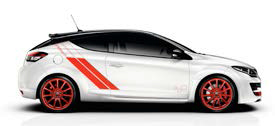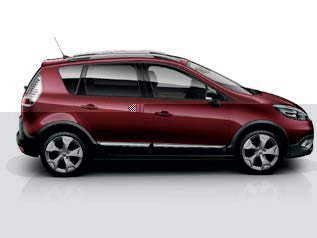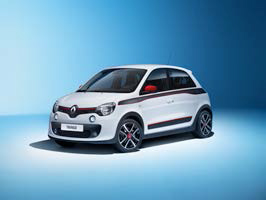Mégane 275 Trophy the greatest
Two laps around the Nürburgring gave Autocar’s Matt Prior the chance to get to know the new Mégane Renaultsport 275 Trophy.
“Now, two laps of a circuit doesn’t usually tell you much. But this is the Nürburgring, so it’s a lot like a 20-minute thrash on a B-road. A smooth, very fast and seriously inclined B-road. Around it, this car is seriously good.
“The changes taking the motor to 275hp are all electronic, and the fact that there’s more torque through more of the rev range means there’s less need to downshift. It’s broad and responsive, and the exhaust makes a belting pop on lift-off.
“The steering and handling are also tremendous. There’s so much feel that you’d swear the steering was hydraulically assisted, not electric, while it has the kind of adjustability and communicativeness that are Renaultsport trademarks.
“Running over the odd kerb edge it was free from harshness, while body movements are so deftly controlled that you’d swear the car was made for this
track. Which, in a way, it was. It’s possible the ability the Trophy shows might not translate to lumpy UK back roads, but my bet is that it will. On this showing, it is the greatest version of today’s greatest hot hatchback,” concludes Prior. [Autocar 18th June]
Mégane snatches ‘Ring record back
“Renaultsport has snatched back the front-wheel drive Nürburgring lap record with its new Mégane 275 Trophy-R,” reports Auto Express. “It posted a time of seven minutes 54.36 seconds to beat the previous record – set in March by Seat’s Leon Cupra – by 4.04 seconds.
“The new model is based on the recently unveiled Mégane 275 Trophy, but is 100kg lighter. Weight is saved through the use of lighter front seats, plus the removal of sound deadening, the back seats, the air-con and the radio. “The new model comes with Ohlins adjustable dampers and Michelin Pilot Sport Cup 2 tyres as standard. There’s also a titanium Akrapovic exhaust.
“The record-breaking Renault has bigger brakes and a lithium-ion battery, saving 16kg. To mark their Trophy-R out, buyers can opt for a two-tone paintjob. The alloys are usually black, but can be finished in red as an option.” [Auto Express 18th June]
Scénic XMOD has crossover appeal
“Unless you need the additional space of the seven-seat model, the Scénic XMOD might just have become Renault’s most appealing MPV,” reckons Fleet World’s Alex Grant. It may lack the four-wheel drive system found on previous Renault crossovers like the Scénic RX4 and Captur, however the Scénic XMOD boasts “an advanced traction control system” with “mud and snow tyres” also included “for low-grip surfaces. Most importantly, though, it has the protective body cladding and raised ride height buyers want from a crossover.
“The more you look into it, the more it impresses. Opting into the XMOD doesn’t add anything to the price of a five-seat Scénic: it’s not less fuel efficient and CAP has given the cross-breed a higher residual value than its traditional MPV sibling.” At Dynamique trim level, the choice of the XMOD over the regular Scénic is “almost a no-brainer even for drivers who never touch the Grip Xtend dial”.
“There’s a real best-of-both-worlds appeal to the XMOD. Traditional crossovers can’t match the flexibility of its MPV-derived interior, which includes three rear seats which not only fold flat but also tumble forwards and can be removed altogether to increase load space. Aside from the Peugeot 3008 – which has a similar system to the XMOD’s – there are no two-wheel drive crossovers with anything to rival the Grip Xtend system.
“Ultimately this isn’t a car for tackling extreme off-road courses, mostly due to the lower ride height, but switching between its three modes means the versatile Renault shouldn’t have any problems with unpredictable British winter weather. In this case, that doesn’t mean lugging a four-wheel drive system around for the rest of the year.
“Gripes are few and far between,” says Grant, noting that “though the latest version of the 110hp 1.5-litre diesel engine is quiet, economical and pulls well, long gearing means driving in third gear in town to avoid labouring.” The XMOD also makes use of the “excellent R-Link infotainment system”, however it is “operated by joystick rather than the usual touchscreen and a little clunkier as a result”.
“But both are things drivers would quickly get used to. Renault expects almost one in five Scénic customers to opt into the XMOD, and if anything perhaps it’s a little reserved for what deserves to be a popular addition to the proven MPV.”
Grant concludes: “With styling closer to the segment’s ever-popular crossovers than a traditional MPV, but with the five-seat Scénic’s practicality and more traction than most drivers will ever need, the XMOD shapes up to be a real asset to the range for those who don’t even need seven seats.” [Fleet World 26th June]
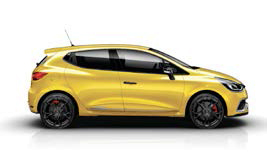 Clio Renaultsport grows up
Clio Renaultsport grows up
“When Renault launched the Clio Renaultsport 200 Turbo, it said that it had aimed to build a car that was easier to live with, that was less manic and less edgy than the hot Clios that had gone before,” says Car’s Steve Moody in his final long-term update. “Having run this car since last summer and found it ridiculously easygoing, it is clear Renaultsport has absolutely nailed the brief handed to it. If you want a hot supermini that can do humdrum, then nothing can match the new Clio Renaultsport.
“The turbocharged engine and automatic dualclutch gearbox require no thought when you can’t be bothered, delivering up the right gear, dollops of lowrev torque and a gentle hum. The seats are superbly comfortable, the infotainment system perfectly workable and the ride firm, but not remotely crashy. There are clearly some quality dampers at play here. “It’s also pretty spacious inside and the five doors are useful when you are transporting a family about, while my kids absolutely loved the fact you could make it sound like a spaceship, or a Clio V6, via the synthesised sounds.” [CAR July]
Twingo could revolutionise city motoring
The Twingo is preparing to “challenge convention by doing things to a radically different formula”, according to the Telegraph’s Chris Knapman. Renault is doing this by putting the engine in the car’s tail. “Being rear-engined defines this 3.5-metre long car in several ways. First, it means that the front wheels can be pushed right to the corners, improving stability and increasing interior space.
“Second, it means that the Twingo will be rear-wheel drive, which gives it more in common with a Porsche than a Panda. We should expect – nay demand – that the Twingo is brilliant fun to drive, with terrific steering.
“Third, and perhaps most importantly, it makes the Twingo if not innovative then certainly interesting. And interesting can do wonders for selling cars.” Power will come from a pair of three-cylinder petrol engines, one turbocharged and the other naturally aspirated. Both “are sure” to emit less than 100g/km of CO2, “meaning they’ll be as cheap as the proverbial chips to run”.
Getting into a pre-production car gave Knapman the chance to see how the interior packaging works in the real world. “For such a diminutive machine there’s a respectable amount of room, the effect enhanced by the standard five-door layout. Other neat touches include a storage hole that runs all the way under the rear bench.
“Up front, there’s a big, clear semi-circular speedo, plenty more cubby holes and some nice, swoopy styling. On this first taste the Twingo blends function with a bit of flair, just as it should. “Assuming it’s as much fun to drive as that rear-engined layout promises, the Twingo has the potential to reinvent how city cars of the future are designed. And if it does that, then maybe, this little Renault will come to be seen as one of the most pivotal cars of the modern age,” concludes Knapman. [Telegraph 12th June]
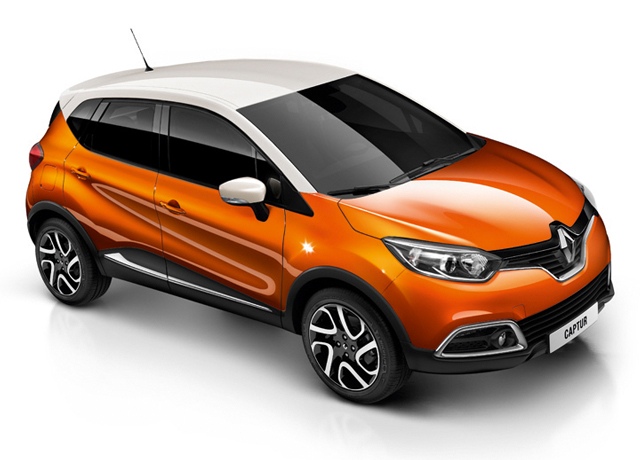 Long-term Captur gets ‘appy
Long-term Captur gets ‘appy
Simon Carrington’s long-term Renault Captur has a “whole host of extras”, including “useful stuff” like parking sensors and Bluetooth, but he’s most interested in the multimedia system which includes R-Link.
“Lots of cars on the market will now tell you how well you’re driving; what I like about the R-Link system is that it also tells you how badly you’re driving and what you can do to improve. So, I can check the on-board system and know that my eco driving score is 69 out of 100, and it tells me that I should not leave the engine idling, nor should I use the air-con in town, and even that I should not leave unnecessary objects in the car as that adds weight, which is bad for my eco score.
“I am very good on acceleration, very steady (nine out of 10) according to the computer; I could do better on anticipation (take foot off accelerator 300 yards from a red light, according to the advice); and I’m terrible on gearchanges, just one out of 10. Apparently, I must change gears quicker.
“I can check the outside air quality, check the fuel prices of the nearest petrol stations, look for local hotels, sync with my calendar and Google tasks and download a calculator. All very useful stuff. “Renault also has a built-in app store, and one free app really stands out from the pack and demands to be downloaded. The Aquarium app is exactly what it sounds like – you can download some digital fish and seaweed to convert the seven-inch screen into, yes, you guessed it… a mobile aquarium.” [Top Gear July]
Renault shows its racing stripes
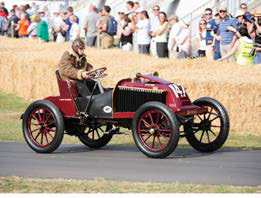 “Renault will show off its race and rally heritage at the Goodwood Festival of Speed,’ reports Honest John’s David Ross. “In fact the French firm is able to span more than a century of motorsport with the 1902 Renault Type K which will take to the famous Goodwood hill once again.”
“Renault will show off its race and rally heritage at the Goodwood Festival of Speed,’ reports Honest John’s David Ross. “In fact the French firm is able to span more than a century of motorsport with the 1902 Renault Type K which will take to the famous Goodwood hill once again.”
1902 was the year that the Type K won the Paris to Vienna race – Renault’s “first international racing victory” – thanks to its “low weight”, which “was a real asset on the race’s hilly roads, and brought Marcel Renault victory, covering 807 miles at an average speed of 38.8mph”.
“Also on the hill will be the 1984 Renault R5 Maxi Turbo,” a “weirdly appealing little car” which was designed as a rival the Lancia Stratos rally car but ended up going into production due to Rally Championship rules, “in the process creating one of Renault’s many legendary performance machines and a highly collectible car today. The Renault 5 Maxi Turbo scored its maiden win on the 1981 Monte Carlo rally, and remained a potent force until the all-wheel drive Group B cars arrived”.
Also on show at the Festival of Speed will be the “spectacular” 1926 Renault 40CV Type NM des Records, a “single seat, streamlined coupé” with a 9.0-litre engine that “covered 50 miles at 118.1mph and went on to achieve a 24-hour average of 107.9mph”, as well as the 1965 Alpine M65 and Alpine A310 Group B, which will both compete in the 2014 Le Mans Classic (the latter of which “will be performing for the first time since its retirement in 1977”).
“Alongside the three Alpines will be the famous Renault RE40 Formula 1 car from 1983,” which was “Renault’s first Formula 1 car to use a carbonfibre tub” and featured “Renault’s now long-running 1.5-litre turbo engine, which was by now running twin turbochargers to achieve 880bhp.” The RE40 took Alain Prost to second place in the F1 World Championship, “scoring four wins from 14 races, three pole positions and three fastest laps” in the process. [Honest John 24th June]
Click here to view the full press release.



